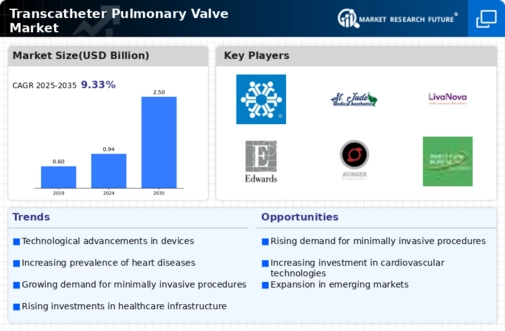Growing Geriatric Population
The aging population is a crucial factor driving the Transcatheter Pulmonary Valve Market. As individuals age, the prevalence of heart-related conditions, including pulmonary valve disorders, tends to increase. The World Health Organization projects that by 2050, the number of people aged 60 years and older will double, reaching over 2 billion. This demographic shift is likely to result in a higher demand for transcatheter interventions, as older patients often prefer minimally invasive procedures that offer quicker recovery times. Consequently, the Transcatheter Pulmonary Valve Market may see a surge in demand as healthcare systems adapt to the needs of this growing population segment.
Rising Awareness and Patient Education
Rising awareness and education regarding heart health are pivotal in driving the Transcatheter Pulmonary Valve Market. As patients become more informed about their treatment options, they are more likely to seek out minimally invasive procedures. Campaigns aimed at educating the public about congenital heart defects and available interventions have gained traction, leading to increased patient inquiries and referrals. Additionally, healthcare professionals are increasingly advocating for transcatheter solutions due to their benefits over traditional surgical methods. This heightened awareness is expected to translate into a growing patient base for transcatheter pulmonary valve procedures, thereby positively impacting the Transcatheter Pulmonary Valve Market.
Technological Innovations in Valve Design
Technological advancements in valve design are significantly influencing the Transcatheter Pulmonary Valve Market. Innovations such as improved biocompatibility, durability, and ease of deployment are enhancing the performance of transcatheter valves. For instance, the development of self-expanding valves has simplified the implantation process, potentially reducing procedure times and improving patient outcomes. Furthermore, the integration of advanced imaging techniques allows for better pre-procedural planning and intraoperative guidance, which may lead to higher success rates. As these technologies continue to evolve, they are likely to attract more healthcare providers to adopt transcatheter solutions, thereby propelling the growth of the Transcatheter Pulmonary Valve Market.
Rising Prevalence of Congenital Heart Defects
The increasing incidence of congenital heart defects (CHDs) is a primary driver for the Transcatheter Pulmonary Valve Market. It is estimated that approximately 1 in 100 births are affected by CHDs, necessitating effective treatment options. As more patients with CHDs reach adulthood, the demand for less invasive solutions, such as transcatheter pulmonary valves, is likely to rise. This trend is further supported by advancements in medical technology that enhance the safety and efficacy of these procedures. The Transcatheter Pulmonary Valve Market is expected to experience growth as healthcare providers seek to address the needs of this expanding patient population, which may lead to an increase in procedural volumes and market revenues.
Increased Investment in Healthcare Infrastructure
Investment in healthcare infrastructure is a significant driver for the Transcatheter Pulmonary Valve Market. Many countries are enhancing their healthcare systems to improve access to advanced medical technologies. This includes the establishment of specialized cardiac centers equipped with the latest transcatheter technologies. As healthcare providers invest in training and resources, the adoption of transcatheter pulmonary valves is likely to increase. Moreover, government initiatives aimed at improving cardiovascular care can further stimulate market growth. The Transcatheter Pulmonary Valve Market stands to benefit from these investments, as they facilitate the implementation of innovative treatment options for patients with pulmonary valve disorders.


















Leave a Comment